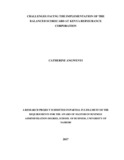| dc.description.abstract | Companies compete in a very complex and challenging context that is as a result of many factors from globalization, aggressive competitors and rapid change in technology among others. For organizations to gain and maintain a competitive edge they must be able to develop and execute strategic plans with precision. One of the major tools that help achieve this is the balanced scorecard. The balanced scorecard was developed in the early 1990’s by Kaplan and Norton and was designed to give companies the information needed to effectively manage their business strategy. It has additional perspectives other than the traditional financial perspective which include customer, internal business and learning and growth. The implementation of the tool has however been a challenge to organizations. Hence the main purpose of the study was to determine the challenges of the implementation of the Balanced Score Card in the insurance sector and specifically at Kenya Reinsurance Corporation. The findings from this study may particularly be useful in providing additional knowledge to Kenya Re and other companies especially in the insurance sector on the implementation of the balanced score card as a strategy implementation tool. The research design used in this study was a case study. Primary data was collected using an interview guide while secondary data was obtained from the company’s records. The researcher thus interviewed eight staff with four being in managerial positions and the other four in non-managerial positions. The researcher used content analysis to analyze the data by describing phenomena, classifying it and seeing how the concepts in the study interconnect. It was established that the organization has been using the balance scorecard since 2010.Some of the benefits of adopting the tool were that it enabled staff to focus on measurable targets, ease of allocating departmental targets to individual staff, helped focus on key KPIS, ability to focus on key objectives, assisted in putting emphasis on specific key measures, helps in the monitoring of performance, assist in the measurement of set targets and helped in the monitoring of performance. The implementation of the balanced score card has however had challenges which included but not limited to lack of clear understanding of the balanced scorecard and its role as a strategy implementation tool, poor leadership involvement, organizational hindrances that included beauracratic structures, lack of human resources ,lack of training to new staff and complex trainings to existent staff ,poor IT support especially for non-financial perspectives , project team specific to the BSC did not include representatives from all key departments, lack of involvement of all staff and departments, BSC design that didn’t show clear link between the various perspectives , poor planning, lack of proper communication ,and resistance of the BSC. The findings of the study should be understood and valuated in light of the limitations of the study. The study is especially useful to Kenya Reinsurance Corporation. The study highlighted institutional practice recommendations to overcome the challenges of the implementation of the balanced scorecard and also provides suggestions for further studies. | en_US |



